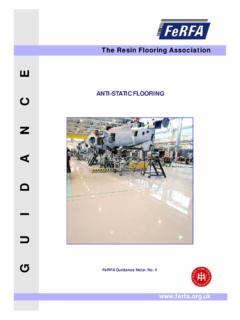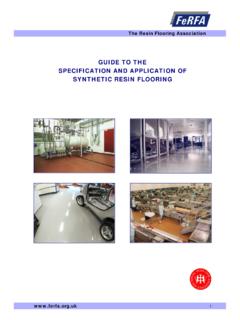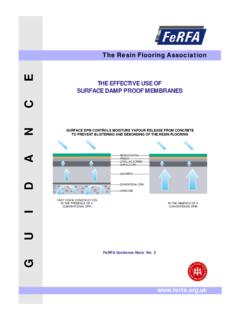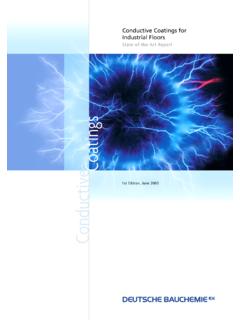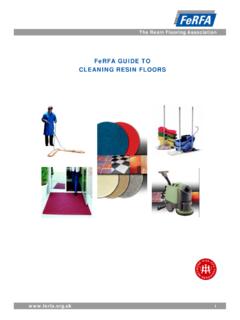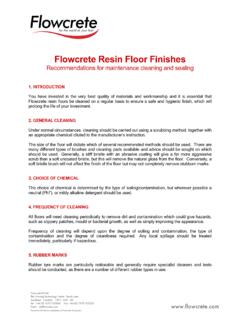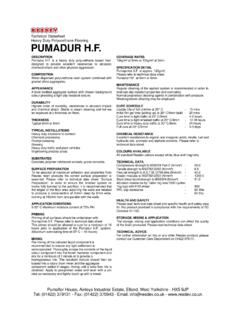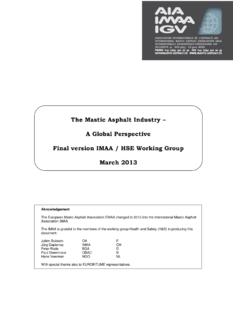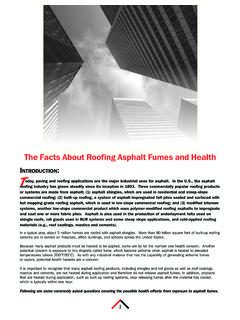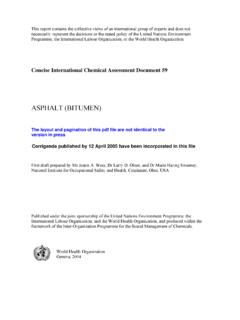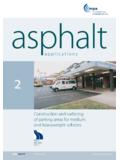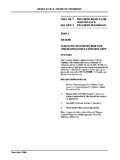Transcription of European standards for In situ Flooring products - …
1 European standards for In situ Flooring products Brian Poulson: Executive Director, FeRFA (The Resin Flooring Association) and member of CEN Technical Committee TC 303 "Floor screeds and in situ floorings in buildings" INTRODUCTION 2002 saw the publication of the first ever performance standard in the UK for Flooring products to be applied in situ. Although published as a British Standard it had been developed as a European standard and issued by the European Committee for Standardization, known as CEN (Comit Europ en de Normalisation). Under CEN rules it will now have been adopted as a national standard by all the participating European countries, including the UK. Publication of the standard was the culmination of 10 years difficult development work by the CEN committee on which there was strong representation from the United Kingdom. The difficulties arose from the need to reconcile different national interests and practices, at the same time providing a standard that was both realistic in its quality requirements without imposing unnecessary burdens in testing costs on manufacturers.
2 Of course there have been standards for in situ floorings in the past but the suite of BS 8204(1) standards covered only the installation procedures and the inspection and testing of the installed floor. They did not attempt to specify in detail the performance properties of the products to be applied. Hence the new European standards are breaking into entirely new ground. THE European Flooring standards The British / European standards that have now been published are: BS EN 13318: Screed materials and floor screeds Definitions It is clearly important that the new standards are unambiguous in interpretation and clearly understood across the whole of Europe. So this standard provides agreed definitions for the technical terms being used in the product standard and provides these in French and German as well as English. BS EN 13813: Screed materials and floor screeds Screed material, Properties and requirements This is the product standard that describes the essential characteristics of Flooring products , specifies the methods by which these characteristics are to be determined and, in some cases, defines minimum levels of acceptable performance.
3 Related to this product standard is a complementary suite of eight test method standards , comprising the following: BS EN 13892: Methods of test for screed materials Part 1 Sampling, making and curing specimens for test Part 2 Determination of flexural and compressive strength Part 3 Determination of wear resistance B hme Part 4 Determination of wear resistance BCA Part 5 Determination of wear resistance to rolling wheel Part 6 Determination of surface hardness Part 7 Determination of resistance to rolling wheel, with floor coverings Part 8 Determination of bond strength European standards for In situ Flooring products FeRFA 2005 1 THE SCREED MATERIAL STANDARD: BS EN 13813 To understand this standard, it is first necessary to define what is meant by screed material, since this controls the range of products that can be claimed to comply with the standard. In fact, the CEN committee has deliberately made the definition of 'screed' extremely broad so that it can cover almost every type of product that is applied in situ to form a floor.
4 The official definition of a screed that is given in BS EN 13318 is: Layer or layers of screed material laid in situ, directly onto a base, bonded or unbonded, or onto an intermediate layer or insulating layer, to obtain one or more of the following purposes: to obtain a defined level; to carry the final Flooring ; to provide a wearing surface. This definition does not have any limits on thickness, nor on the method of application. It can therefore include levelling screeds and smoothing compounds as well as wearing screeds, whether these are applied by trowel or flowed or pumped into place. By its breadth it introduces a new much wider meaning to the word 'screed' which hitherto has been largely confined to materials that are trowel-applied and levelled off with screeding bars. Also it is not confined to intermediate layers but applies equally to the finished surface. Almost the only type of in situ floor that does not fall within the scope of the standard is a directly finished concrete slab.
5 There is a restriction though, in that the standard is intended to apply only to products manufactured in a factory. Compliance is then claimed for the product in the state that it leaves the 'factory gate'. Consequently it does not strictly apply to products that are site-batched, even if the constituents are all of standard quality. However there is a footnote which states that "the standard can be used in conjunction with codes of application and national specifications for site made material produced and laid by the same contractor". The catch is that the contractor must also be able to demonstrate a quality control system comparable to that which would apply in a factory. TYPES OF SCREED Five different categories of product are identified in the standard, differentiated by their binder type: these are CT cementitious CA calcium sulfate MA magnesite AS mastic asphalt SR synthetic resin and different performance requirements are set for each type.
6 Polymer modified cement screed materials, frequently used for levelling or installing falls under resin or other floorings are included in the cementitious category, but then carry a 'polymer-modified CT' designation. The traditional 'granolithic' or similar type screed materials can similarly carry a 'hard aggregate CT' designation. PERFORMANCE REQUIREMENTS The European standard specifies the essential performance characteristics for each type of screed material, and this is summarised in Table 1. European standards for In situ Flooring products FeRFA 2005 2 Table 1: Screed materials and tests that apply to each type Screed materials based on : compressive strength flexural strength wear resistance "B hme" wear resistance "BCA" wear resistance to rolling wheel surface hardness resistance to indentation resistance to rolling wheel with floor covering setting time shrinkage and swelling consistency pH value modulus of elasticity Impact resistance bond strength Cement N N N (one of three)
7 O - O O O O O O O O Calcium sulfate N N O O O O - O O O O N O - O Magnesite N N O O O N - O - O O O O - O Mastic asphalt - - O O O - N O - - - - - - - Synthetic resin O O - N (one of two) O - O - O O - O N N This table describes the basic characteristics. The letter 'N' signifies Normative (the 'Eurospeak' for mandatory) which means that the product type must be tested for that characteristic. The letter 'O' signifies Optional, in effect, where relevant.
8 The intention is that the manufacturer can choose whether to declare a value for that particular characteristic. Alternatively, a specifier may require a product with a minimum level of an 'optional' characteristic if it is regarded as important for a particular application. Standard test methods are specified for each of these characteristics and must be used if compliance with the standard is claimed. WEAR RESISTANCE Probably the most controversial characteristic to be assessed is wear resistance, where three alternative test methods are specified, because agreement on a single method could not be reached. In the UK we are most familiar with the BCA tester that for some years has been specified in BS 8204-2(2), but there is negligible experience here with the Swedish Rolling wheel or the German B hme machines. Unfortunately it is not yet known whether there is a direct correlation between the three tests.
9 Developed in different countries, there have been only limited attempts to compare the results obtained with a range of typical products . The long term intention is that once there is practical experience of the operation of the standard then hopefully a consensus will emerge on which of the three methods should eventually be used as standard. This is not an ideal situation as in the meantime it could signify that certified products tested on different machines are not strictly equivalent! SPECIAL CHARACTERISTICS The standard also lists a number of special characteristics that may become relevant in particular situations. In each case a test method is specified and must be used if compliance with this standard is claimed for any particular characteristic. Important characteristics included here include chemical resistance, electrical resistance (for anti-static or conductive floors) and thermal or acoustic insulation.
10 European standards for In situ Flooring products FeRFA 2005 3 CE MARKING If a product meets all the relevant requirements of the standard, the manufacturer is entitled to affix a CE mark to the packaging or label or delivery note for the screed material. This CE mark signifies that a product meets the technical requirements of the standard and that the specified system of attestation of conformity has been applied. In the case of screed materials conforming to BS EN 13813 there is no requirement for any independent certification for the product. This arises because the level of Attestation of Conformity for such products has been set by the European Commission, so that all testing and quality assurance remain the sole responsibility of the manufacturer, without any independent certification being necessary. CE marking has now been implemented throughout the member states of the EU, but is not a legal requirement in the UK at present.
